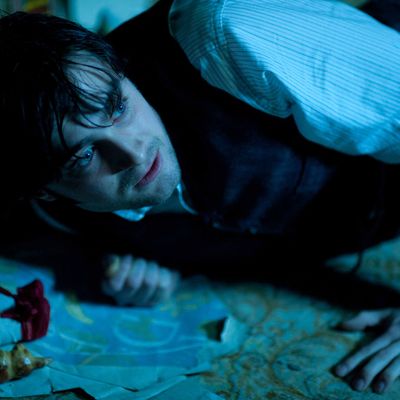
The studiously old-fashioned English ghost picture The Woman in Black opens with three picture-perfect little girls fixing the camera with blank stares, rising, walking to the window (stepping on and crushing their dolls along the way), and, in unison, jumping to their deaths. It should be the most nightmarish vision imaginable  the senseless end of three beautiful children  but ones principal thought is, And  ? The banality of the images and the lack of emotional heft promptly establish the director, James Watkins, as a plodder unable to rise to the occasion, and none of what follows alters that grim perception. Children die all through the picture, but theyre fodder. The film is a ghost of ghost stories past.
ItÔÇÖs getting attention, of course, as the first post-Potter starring vehicle for Daniel Radcliffe, who plays an attorney shipped off to the gray English coast to ready a desolate mansion ÔÇö inaccessible when the tide rises ÔÇö for sale. That it is haunted is apparent on first glimpse. Now the vengeful, eponymous wraith is visible in the window, now all over the grounds. She might as well have a plate of cookies sitting out for him. And itÔÇÖs never entirely clear what heÔÇÖs accomplishing by poring over the late homeownerÔÇÖs epistles apart from waiting for the ghost to show up and say, ÔÇ£Boo!ÔÇØ Looking pinched and fairly cadaverous himself, Radcliffe plays the role earnestly and without imagination. Does he already seem middle-aged? Watching him and his co-stars in the final Potter movie, I wanted to sing, ÔÇ£Sunrise, Sunset.ÔÇØ Now he looks as if he should be singing it.
The Lady in Black is a Hammer co-production, another blow to those of us weaned on the work of Peter Cushing and Christopher Lee and hoping against all reason to go home again. (To be fair, the Hammer-produced Let Me In, an English-language remake of Let the Right One In, was well done but failed to scare up any box office.) There is a suspicious local innkeeper in the mode of Hammer stalwart Michael Ripper and excellent, subtly expressionist interiors in shades of black, white, and brown. There is one nice pop-up scare against a dozen or so false, ineffectual ones ÔÇö a poor percentage. As the title states, she is a woman and wears black, but she might as well be a hastily decked-out script girl for all her impact.
Two expert actors, Ciaran Hinds and Janet McTeer, show up as a well-off, hospitable local couple who lost a son and are good for several lines of exposition. (ÔÇ£Whenever sheÔÇÖs been seen there has always been one sure and certain result!ÔÇØ) Will Radcliffe flee the village (and thereby lose his job back in London) or try to appease the spirit, herself a grieving mother? More to the point, where are Hermione and Ron when he needs them?
McTeer, in telepathic contact with her dead child, spasmodically carves symbols on her dining room table and issues warnings from beyond the grave. She is quite good under the circumstances and one hopes the paycheck will help her accessorize for her coming appearance at the Academy Awards. (She wonÔÇÖt win but should.) Another reason to wish for HammerÔÇÖs rebirth is that the studio, however parsimonious, helped British stage actors live in relative comfort for many decades. And RadcliffeÔÇÖs presence here is a sad reminder that the Harry Potter gravy train that bought so many splendid Brits their country cottages has left the station.


